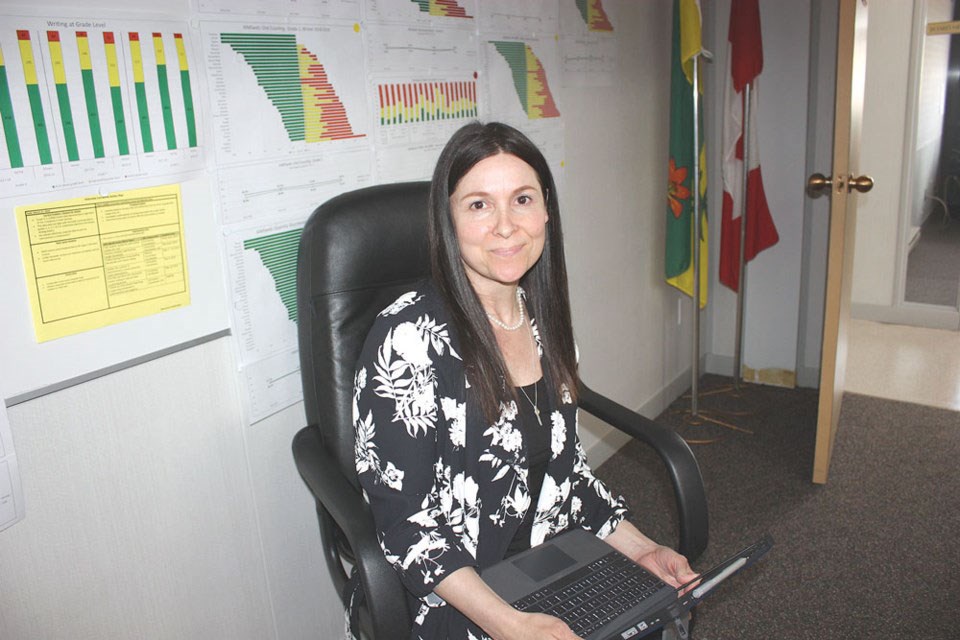WEYBURN - The activities and tools youngsters pick up and use in the first few years of their lives are key components that often lead to success in structured classrooms and social settings for the rest of their lives.
With that in mind, Jacquelene Gibbs, co-ordinator of early learning for the South East Cornerstone Public School Division, figuratively walked the board members through a 40-minute presentation featuring highlights of the work being carried out by the early learning teams in the school division.
She made the presentation during the board’s regular monthly public meeting on Jan. 19 in the division’s head office in Weyburn, with a few board members joining the live-streaming session via an online service.
Gibbs took time to praise and thank Madeleine Valentine, a long-serving member of that team who was also present for the occasion. Valentine is soon to retire from her role as the regional Kids First manager after 20 years in the early learning systems.
At the start of her presentation, Gibbs said, “This is how and why we tend to the business of connections,” while pointing to video graphs indicating outcomes of early intervention exercises that set young bodies and minds into successful paths.
She noted how sensory pathways are being developed even before birth.
The investment the school division has made in early learning definitely pays off, she said, pointing to the graphic for data driven proof.
“There is an explosion of learning early in life, especially in the first year, so economically, it just makes sense. There is rapid development in cognizant functions, the language, then control of body and space and the young people just build upon that,” she added.
“When parents are talking to them, they are layering in language and after about a year, the brain develops a little more slowly, that’s when we begin to help parents. Sometimes it’s families, or communities or teachers who need the support.”
The early learning team provides home visitation services (pre and post COVID) until the child is safely in the care of a schoolroom setting.
There are day care and family resource centres and head start programs, plus kindergarten, and where they’ve been and where they are headed is documented, she explained.
“When the learners, if they are involved, are reflecting on what they’ve learned, that’s great,” she said, pointing to examples of young people who realize the purpose of the lessons and activities they are engaged in.
The caseload graph, she pointed out, tells the story of how COVID-19 has impacted the program, stalling some programs. But, with flexible and clever practitioners involved in the team, they usually found a way around the COVID barriers to provide alternative projects.
“I think we’ve now turned that corner,” she said, referring to the stubborn COVID barriers. “It’s difficult to track progress when there is limited engagement, and the graph shows that when we weren’t doing family visits.”
Referrals from other agencies dipped as programs were shut down and consultative caseloads grew but now referrals have jumped again and have been placed into active caseloads. “People are re-joining us,” she said.
Test periods, she noted, allows for the collection of adaptive and cognitive skills as well as fine and gross motor skills, plus general social and social communication skills in the youngsters. Over a three-year period there is generally a great path of progress.
With new home visits now being planned, the team is connecting with family centres or making the visits in outdoor settings with masking and sanitation protocols in effect. This allows them to carry them out in that manner. She said in many respects this is change for the better since it puts the 13 team members in family resource centre settings rather than homes and the children can focus on social communication skills and use of resources while they engage with other children and adults.
Home visits for kindergarten students will resume since their successes have been proven, Gibbs said. Information items are sent to parents so they will understand what will go on and how their child will be assisted.
To support her statements on progress, Gibbs used another chart to outline how social skills and reading program comparisons from 2014-2021 indicated a continual improvement and even the arrival of COVID has taught some lessons since, “the COVID era has allowed children to become more aware of self. They have been processing this reality through play and it will be interesting to see how this plays out over the years.”
Speech language pathology is another path within the early learning program and now that they have a full complement of SLP personnel, they have been able to engage parents more effectively, Gibbs said, and that has led to a significant increase in the successful “graduation” of more kids.
The team also gathers information and collaboration items for Kindergarten teachers and that has been impactful during the pandemic pauses that led to on-line learning while other things were being put on the back burners.
That means some reflection time with Grade 3 teachers in the months ahead, she suggested.
Reconciliation lessons are also in the mix with First Nations culture and language pursuits, since, she pointed out, “English isn’t our only language,”
She said they will be meeting with the Aboriginal knowledge keepers and those who know and teach the Nakota language and they “will keep on this path until we reach parity,” she said, noting there are currently 60 youngsters with First Nations heritage engaged in the programs.




